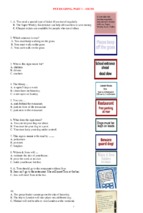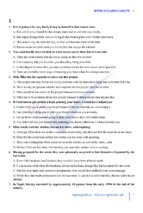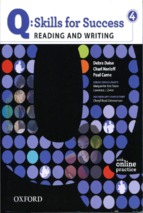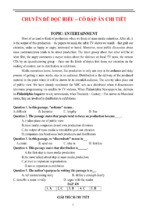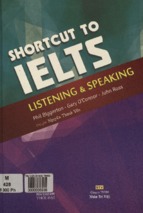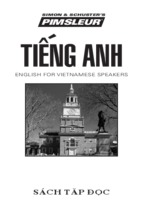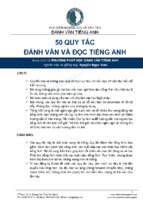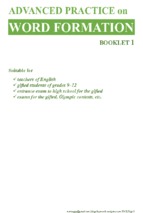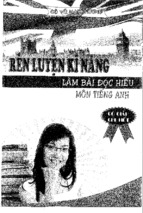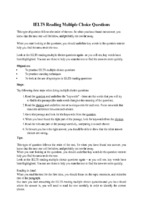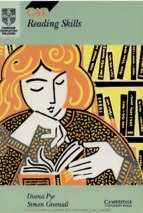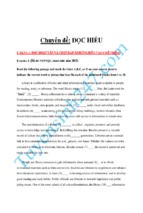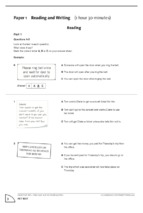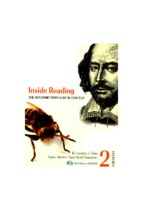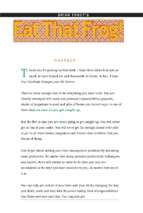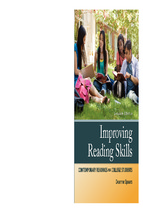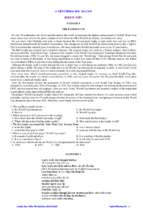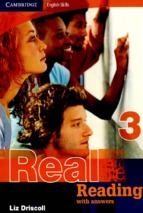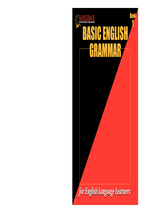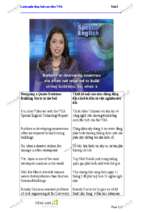A02_NADE8714_07_SE_FM.QXD
12/6/07
9:43 PM
Page i
Why Do You Need
this New Edition?
The requirements, strategies, and tools
for college writing assignments have
changed in many ways since the last
edition of The Longman Writer was
published, so make sure you’re up to
date! If you’re still wondering why you
should buy this new edition, here are a
few more great reasons:
��� New visual source samples show you where in
books, online periodicals, and subscription
databases you can find all the information you
need to cite your sources in research papers
(Ch. 20).
��� New Essay Structure Diagrams outline the
structure of professional readings to help you
use the reading as a pattern for your own writing (Chs. 10–18).
��� New Process Diagrams spotlight each step of the
writing process to help you see how to break
down your writing assignments into manageable tasks (Chs. 2–9).
��� New sample student essays written in both MLA
and APA formats are annotated to offer guidance
and models for writing research papers in the
academic style required by your course (Ch. 20).
��� New Development Diagrams highlight distinctive
features of different patterns of development for
writing, summarizing chapter content to help you
find key concepts quickly (Chs. 10–18).
��� Eleven new readings have been added in
chapters 10–18 on current topics such as slang,
high school football, and e-mail style that are
models for the different patterns of writing that
you’ll be learning and practicing.
��� New guidance on creating and following a
writing schedule combined with new tips for
more efficient online research help you make
the most of your time when writing research
papers (Ch. 19).
��� New advice on evaluating, using, and citing electronic sources explains how to use the most
current online information sources—like blogs
and wikis—credibly (Ch. 19).
��� A new appendix, “A Guide to Avoiding Plagiarism,”
provides the concrete guidelines you need to
avoid unintentional plagiarism and its
consequences.
10
And now—use The Longman Writer alongside
Pearson’s unique MyCompLab and find a world
of resources developed specifically for you!
A02_NADE8714_07_SE_FM.QXD
12/6/07
9:43 PM
Page ii
About the Authors
Judith Nadell was until several years ago Associate Professor of Communications at
Rowan University (New Jersey). During her eighteen years at Rowan, she coordinated
the introductory course in the Freshman Writing Sequence and served as Director of the
Writing Lab. In the past several years, she has developed a special interest in grassroots
literacy. Besides designing an adult-literacy project, a children’s reading-enrichment
program, and a family-literacy initiative, she has worked as a volunteer tutor and a tutor
trainer in the programs. A Phi Beta Kappa graduate of Tufts University, she received a
doctorate from Columbia University. She is the author of Becoming a Read-Aloud
Coach (Townsend Press) and coauthor of Doing Well in College (McGraw-Hill), Vocabulary
Basics (Townsend Press), and The Longman Reader. The recipient of a New Jersey award for
excellence in the teaching of writing, Judith Nadell lives with her coauthor husband, John
Langan, near Philadelphia.
John Langan has taught reading and writing at Atlantic Cape Community College near
Atlantic City, New Jersey, for more than twenty-five years. Before teaching, he earned
advanced degrees in writing at Rutgers University and in reading at Rowan University.
Coauthor of The Longman Reader and author of a series of college textbooks on both reading and writing, he has published widely with McGraw-Hill Book Company, Townsend
Press, and Longman. Through Townsend Press, his educational publishing company, he
has developed the nonprofit “Townsend Library”—a collection of more than fifty new and
classic stories that appeal to readers of any age.
Eliza A. Comodromos has taught composition and developmental writing in the English
Departments of both Rutgers University and John Jay College of Criminal Justice. After
graduating with a B.A. in English and in French from La Salle University, she did graduate
work at the City University of New York Graduate School and went on to earn an advanced
degree at Rutgers University, New Brunswick. A freelance editor and textbook consultant,
Eliza has delivered numerous papers at language and literature conferences around the
country. She lives with her husband, Paul Langan, and daughters, Anna Maria and Sophia
Mae, near Philadelphia.
ii
A02_NADE8714_07_SE_FM.QXD
12/6/07
9:43 PM
Page iii
THE
LONGMAN
WRITER
RHETORIC, READER, RESEARCH
GUIDE, AND HANDBOOK
SEVENTH EDITION
JUDITH NADELL
JOHN LANGAN
Atlantic Cape Community College
ELIZA A. COMODROMOS
New York San Francisco Boston
London Toronto Sydney Tokyo Singapore Madrid
Mexico City Munich Paris Cape Town Hong Kong Montreal
A02_NADE8714_07_SE_FM.QXD
12/6/07
9:43 PM
Page iv
ACQUISITIONS EDITOR:
SENIOR DEVELOPMENT EDITOR:
SENIOR SUPPLEMENTS EDITOR:
SENIOR MEDIA PRODUCER:
SENIOR MARKETING MANAGER:
PRODUCTION MANAGER:
PROJECT COORDINATION, TEXT DESIGN,
AND ELECTRONIC PAGE MAKEUP:
SENIOR COVER DESIGN MANAGER:
COVER DESIGNER:
PHOTO RESEARCHER:
SENIOR MANUFACTURING BUYER:
PRINTER AND BINDER:
COVER PRINTER:
Lauren A. Finn
Anne Brunell Ehrenworth
Donna Campion
Stefanie Liebman
Sandra McGuire
Eric Jorgensen
Elm Street Publishing Services
Nancy Danahy
Nancy Sacks
Photosearch, Inc.
Dennis J. Para
Quebecor World Book Services/Taunton
Coral Graphic Services, Inc.
For permission to use copyrighted material, grateful acknowledgment is made to the
copyright holders on pp. 729–730, which are hereby made part of this copyright page.
Library of Congress Cataloging-in-Publication Data
Nadell, Judith.
The Longman writer: rhetoric, reader, research guide, handbook/Judith Nadell,
John Langan, Eliza A. Comodromos.—7th ed.
p. cm.
Includes bibliographical references and index.
ISBN-13: 978-0-205-59871-7
ISBN-13: 978-0-205-59870-0 (brief edition)
ISBN-13: 978-0-205-64226-7 (concise edition)
1. English language—Rhetoric. 2. English language—Grammar—Handbook,
manuals, etc. 3. College readers. 4. Report writing. I. Langan, John, 1942–
II. Comodromos, Eliza A. III. Title.
PE1408.N19 2007
808'.0427—dc22
2007041534
Copyright © 2009 by Pearson Education, Inc.
All rights reserved. No part of this publication may be reproduced, stored in a retrieval
system, or transmitted, in any form or by any means, electronic, mechanical, photocopying,
recording, or otherwise, without the prior written permission of the publisher. Printed in
the United States.
Please visit us at www.ablongman.com/Nadell
ISBN-13: 978-0-205-59871-7 (Full edition)
ISBN-10: 0-205-59871-4 (Full edition)
ISBN-13: 978-0-205-59870-0 (Brief edition)
ISBN-10: 0-205-59870-6 (Brief edition)
ISBN-13: 978-0-205-64226-7 (Concise edition)
ISBN-10: 0-205-64226-8 (Concise edition)
1 2 3 4 5 6 7 8 9 10—QWT—11 10 09 08
A02_NADE8714_07_SE_FM.QXD
12/6/07
9:43 PM
Page v
Contents
PREFACE
xvi
PART I
THE READING PROCESS
1
1 BECOMING A STRONG READER
1
1: Get an Overview of the Selection 2
2: Deepen Your Sense of the Selection 3
STAGE 3: Evaluate the Selection
4
STAGE
STAGE
Ellen Goodman, “Family Counterculture”
PART II
6
THE WRITING PROCESS
12
2 GETTING STARTED THROUGH PREWRITING
Observations About the Writing Process
Use Prewriting to Get Started 14
12
12
Keep a Journal
15
The Pre-Reading Journal Entry
16
Understand the Boundaries of the Assignment
18
Determine Your Purpose, Audience, Tone, and Point of View
Discover Your Essay’s Limited Subject
23
Generate Raw Material About Your Limited Subject
26
Organize the Raw Material
31
Activities: Getting Started Through Prewriting
3 IDENTIFYING A THESIS
What Is a Thesis?
36
Finding a Thesis
37
Writing an Effective Thesis
19
33
36
38
Tone and Point of View
39
Implied Pattern of Development
39
v
A02_NADE8714_07_SE_FM.QXD
12/6/07
9:43 PM
Page vi
vi
Contents
Including a Plan of Development
39
Don’t Write a Highly Opinionated Statement
Don’t Make an Announcement
40
Don’t Make a Factual Statement
40
Don’t Make a Broad Statement
41
Arriving at an Effective Thesis
Placing the Thesis in an Essay
Activities: Identifying a Thesis
40
41
42
42
4 SUPPORTING THE THESIS WITH EVIDENCE
What Is Evidence?
45
How Do You Find Evidence?
45
46
How the Patterns of Development Help Generate Evidence
Characteristics of Evidence
46
47
The Evidence Is Relevant and Unified
48
The Evidence Is Specific
49
The Evidence Is Adequate
50
The Evidence Is Dramatic
50
The Evidence Is Accurate
51
The Evidence Is Representative
51
Borrowed Evidence Is Documented
51
Activities: Supporting the Thesis with Evidence
52
5 ORGANIZING THE EVIDENCE
54
Use the Patterns of Development
55
Select an Organizational Approach 55
Chronological Approach
56
Spatial Approach
56
Emphatic Approach
57
Simple-to-Complex Approach
57
Prepare an Outline
58
Activities: Organizing the Evidence
61
6 WRITING THE PARAGRAPHS IN THE FIRST DRAFT
How to Move from Outline to First Draft
64
General Suggestions on How to Proceed 65
If You Get Bogged Down 65
A Suggested Sequence for Writing the First Draft
Write the Supporting Paragraphs
66
Write Other Paragraphs in the Essay’s Body
Write the Introduction
79
Write the Conclusion
82
Write the Title
84
64
66
78
Pulling It All Together
84
Sample First Draft
85
Harriet Davids, “Challenges for Today’s Parents”
86
A02_NADE8714_07_SE_FM.QXD
12/6/07
9:43 PM
Page vii
vii
Contents
Commentary
87
Activities: Writing the Paragraphs in the First Draft
88
7 REVISING OVERALL MEANING, STRUCTURE,
AND PARAGRAPH DEVELOPMENT
Five Strategies to Make Revision Easier
95
96
Set Your First Draft Aside for a While
96
Work from Printed Text
97
Read the Draft Aloud
97
View Revision as a Series of Steps
98
Evaluate and Respond to Instructor Feedback
Peer Review: An Additional Revision Strategy
Evaluate and Respond to Peer Review
101
98
99
Revising Overall Meaning and Structure
103
Revising Paragraph Development
104
Sample Student Revision of Overall Meaning, Structure,
and Paragraph Development
106
Activities: Revising Overall Meaning, Structure, and Paragraph
Development
107
8 REVISING SENTENCES AND WORDS
Revising Sentences
110
Make Sentences Consistent with Your Tone
Make Sentences Economical
112
Vary Sentence Type
115
Vary Sentence Length
118
Make Sentences Emphatic 120
Revising Words
110
110
124
Make Words Consistent with Your Tone
124
Use an Appropriate Level of Diction
125
Avoid Words That Overstate or Understate
126
Select Words with Appropriate Connotations
126
Use Specific Rather Than General Words
127
Use Strong Verbs
128
Delete Unnecessary Adverbs
130
Use Original Figures of Speech
130
Avoid Sexist Language
132
Sample Student Revision of Sentences and Words
Activities: Revising Sentences and Words
135
9 EDITING AND PROOFREADING
Edit Carefully
140
Use the Appropriate Manuscript Format
Proofread Closely
142
135
139
141
A02_NADE8714_07_SE_FM.QXD
12/6/07
9:43 PM
Page viii
viii
Contents
Student Essay: From Prewriting Through Proofreading
Harriet Davids, “Challenges for Today’s Parents”
Commentary
145
Activities: Editing and Proofreading
148
PART III THE PATTERNS
OF DEVELOPMENT
150
10 DESCRIPTION
150
What Is Description?
150
How Description Fits Your Purpose and Audience
Prewriting Strategies
153
Strategies for Using Description in an Essay
153
Revision Strategies
158
Student Essay: From Prewriting Through Revision
Marie Martinez, “Salt Marsh”
Commentary
162
Activities: Description
143
144
151
159
160
165
Prewriting Activities
165
Revising Activities
165
Professional Selections: Description
167
Maya Angelou, “Sister Flowers”
167
David Helvarg, “The Storm This Time”
Gordon Parks, “Flavio’s Home”
182
Additional Writing Topics: Description
174
188
11 NARRATION
191
What Is Narration?
191
How Narration Fits Your Purpose and Audience
192
Prewriting Strategies
193
Strategies for Using Narration in an Essay
194
Revision Strategies
200
Student Essay: From Prewriting Through Revision 201
Paul Monahan, “If Only”
Commentary
204
Activities: Narration
203
206
Prewriting Activities
206
Revising Activities
207
Professional Selections: Narration
208
Audre Lorde, “The Fourth of July”
208
George Orwell, “Shooting an Elephant”
214
Charmie Gholson, “Charity Display?” 220
Additional Writing Topics: Narration
224
A02_NADE8714_07_SE_FM.QXD
12/6/07
9:43 PM
Page ix
ix
Contents
12 ILLUSTRATION
226
What Is Illustration?
226
How Illustration Fits Your Purpose and Audience
Prewriting Strategies
229
Strategies for Using Illustration in an Essay
230
Revision Strategies
235
Student Essay: From Prewriting Through Revision
Michael Pagano, “Pursuit of Possessions”
Commentary
239
Activities: Illustration
227
236
238
243
Prewriting Activities
243
Revising Activities
243
Professional Selections: Illustration
245
Kay S. Hymowitz, “Tweens: Ten Going on Sixteen”
Beth Johnson, “Bombs Bursting in Air”
252
Leslie Savan, “Black Talk and Pop Culture”
258
Additional Writing Topics: Illustration
245
265
13 DIVISION-CLASSIFICATION
268
What Is Division-Classification?
268
How Division-Classification Fits Your Purpose and Audience
Prewriting Strategies
272
Strategies for Using Division-Classification in an Essay
272
Revision Strategies
277
Student Essay: From Prewriting Through Revision 278
Gail Oremland, “The Truth About College Teachers”
Commentary
282
Activities: Division-Classification
270
279
285
Prewriting Activities
285
Revising Activities
286
Professional Selections: Division-Classification
287
William Lutz, “Doublespeak”
288
Scott Russell Sanders, “The Men We Carry in Our Minds”
David Brooks, “Psst! ‘Human Capital’”
301
Additional Writing Topics: Division-Classification
304
14 PROCESS ANALYSIS
307
What Is Process Analysis?
307
How Process Analysis Fits Your Purpose and Audience
308
Prewriting Strategies
310
Strategies for Using Process Analysis in an Essay
310
Revision Strategies
316
Student Essay: From Prewriting Through Revision 317
Robert Barry, “Becoming a Recordoholic”
295
319
A02_NADE8714_07_SE_FM.QXD
12/6/07
9:43 PM
Page x
x
Contents
Commentary
322
Activities: Process Analysis
324
Prewriting Activities
324
Revising Activities
325
Professional Selections: Process Analysis
Clifford Stoll, “Cyberschool”
328
Diane Cole, “Don’t Just Stand There”
David Shipley, “Talk About Editing”
327
333
340
Additional Writing Topics: Process Analysis
344
15 COMPARISON-CONTRAST
346
What Is Comparison-Contrast?
346
How Comparison-Contrast Fits Your Purpose and Audience
Prewriting Strategies
348
Strategies for Using Comparison-Contrast in an Essay
349
Revision Strategies
354
Student Essay: From Prewriting Through Revision 355
Carol Siskin, “The Virtues of Growing Older”
Commentary
359
Activities: Comparison-Contrast
347
357
362
Prewriting Activities
362
Revising Activities
363
Professional Selections: Comparison-Contrast
364
Toni Morrison, “A Slow Walk of Trees”
364
Patricia Cohen, “Reality TV:
Surprising Throwback to the Past?”
370
Eric Weiner, “Euromail and Amerimail”
375
Additional Writing Topics: Comparison-Contrast
379
16 CAUSE-EFFECT
382
What Is Cause-Effect?
382
How Cause-Effect Fits Your Purpose and Audience
Prewriting Strategies
384
Strategies for Using Cause-Effect in an Essay
385
Revision Strategies
392
Student Essay: From Prewriting Through Revision
Carl Novack, “Americans and Food”
Commentary
397
Activities: Cause-Effect
383
393
395
400
Prewriting Activities
400
Revising Activities
401
Professional Selections: Cause-Effect
402
Stephen King, “Why We Crave Horror Movies”
Buzz Bissinger, “Innocents Afield”
407
402
A02_NADE8714_07_SE_FM.QXD
12/6/07
9:43 PM
Page xi
xi
Contents
Brent Staples, “Black Men and Public Space”
Additional Writing Topics: Cause-Effect
412
416
17 DEFINITION
419
What Is Definition?
419
How Definition Fits Your Purpose and Audience
420
Prewriting Strategies
421
Strategies for Using Definition in an Essay
422
Revision Strategies
426
Student Essay: From Prewriting Through Revision 427
Laura Chen, “Physics in Everyday Life”
Commentary
431
Activities: Definition
429
434
Prewriting Activities
434
Revising Activities
434
Professional Selections: Definition
435
K. C. Cole, “Entropy” 436
James Gleick, “Life As Type A”
441
Natalie Angier, “The Cute Factor”
446
Additional Writing Topics: Definition
452
18 ARGUMENTATION-PERSUASION
455
What Is Argumentation-Persuasion?
455
How Argumentation-Persuasion Fits Your Purpose
and Audience
456
Prewriting Strategies
460
Strategies for Using Argumentation-Persuasion in an Essay
Revision Strategies
477
Student Essay: From Prewriting Through Revision 478
Mark Simmons, “Compulsory National Service”
Commentary
487
Activities: Argumentation-Persuasion
460
481
491
Prewriting Activities
491
Revising Activities
492
Professional Selections: Argumentation-Persuasion
494
Stanley Fish, “Free-Speech Follies”
495
Mary Sherry, “In Praise of the ‘F’ Word”
502
Debating the Issues: Date Rape
506
Camille Paglia, “Rape: A Bigger Danger Than Feminists Know”
Susan Jacoby, “Common Decency”
512
Debating the Issues: Immigration
516
Roberto Rodriguez, “The Border on Our Backs”
517
Star Parker, “Se Habla Entitlement”
521
Additional Writing Topics: Argumentation-Persuasion
526
506
A02_NADE8714_07_SE_FM.QXD
12/6/07
9:43 PM
Page xii
xii
Contents
PART IV
THE RESEARCH PAPER
528
19 LOCATING, EVALUATING, AND INTEGRATING
RESEARCH SOURCES
Plan the Research
528
529
Understand the Paper’s Boundaries
529
Understand Primary Versus Secondary Research
Choose a General Subject
Prewrite to Limit the General Subject
Conduct Preliminary Research
534
Identify a Working Thesis
535
Make a Schedule
536
Find Sources in the Library
530
532
534
536
The Computerized Catalog
536
The Reference Section
540
Periodicals 541
Use the Internet
547
The Internet and the World Wide Web
547
What the Web Offers
547
The Advantages and Limitations of the Library and the Web
Using Online Time Efficiently
549
Using the Net to Find Materials on Your Topic
550
Using Discussion Groups and Blogs
554
Using Wikis
554
Evaluating Online Materials
555
Using Other Online Tools
556
Prepare a Working Bibliography
556
Take Notes to Support the Thesis with Evidence
Before Note-Taking: Evaluate Sources
558
Before Note-Taking: Refine Your Working Bibliography
Before Note-Taking: Read Your Sources
561
When Note-Taking: What to Select
562
When Note-Taking: How to Record Statistics
562
When Note-Taking: Recording Information
563
When Note-Taking: Photocopies and Printouts
565
Kinds of Notes
566
Plagiarism
570
Combining Notes
572
548
557
559
Activities: Locating, Evaluating, and Integrating
Research Sources
573
20 WRITING THE RESEARCH PAPER
Refine Your Working Thesis
Sort Your Notes
577
576
576
A02_NADE8714_07_SE_FM.QXD
12/6/07
9:43 PM
Page xiii
xiii
Contents
Organize the Evidence by Outlining
Write the First Draft
579
577
Presenting the Results of Primary Research
581
Document Borrowed Material to Avoid Plagiarism: MLA Format
Indicate Author and Page
582
Special Cases of Authorship
585
Special Cases of Pagination
587
Blending Quotations into Your Text
Presenting Statistics
590
587
Revise, Edit, and Proofread the First Draft
Prepare the Works Cited List: MLA Format
Citing Book Sources
593
Citing Periodical Sources
597
Citing Electronic Sources
599
Citing Other Nonprint Sources
581
590
593
603
Document Borrowed Material to Avoid Plagiarism: APA Format
Parenthetic Citations
604
References List
605
Citing Book Sources
606
Citing Periodical Sources
608
Citing Electronic Sources
609
Citing Other Nonprint Sources
604
611
A Note About Other Documentation Systems
611
Student Research Paper: MLA-Style Documentation
611
Brian Courtney, “America’s Homeless: How the Government Can
Help”
613
Commentary
629
Student Research Paper: APA-Style Documentation
Activities: Writing the Research Paper
632
PART V
THE LITERARY PAPER
AND EXAM ESSAY
21 WRITING ABOUT LITERATURE
Elements of Literary Works
Literary Terms
635
637
Read to Form a General Impression
637
Ask Questions About the Work
637
Reread and Annotate
638
Modify Your Annotations
639
Write the Literary Analysis
639
Prewrite
639
Identify Your Thesis
640
Support the Thesis with Evidence
Organize the Evidence
642
634
634
635
How to Read a Literary Work
629
642
A02_NADE8714_07_SE_FM.QXD
12/6/07
9:43 PM
Page xiv
xiv
Contents
Write the First Draft
643
Revise Overall Meaning, Structure, and Paragraph Development
Edit and Proofread
646
Pulling It All Together
646
Read to Form a General Impression
646
Langston Hughes, “Early Autumn”
Ask Questions About the Work
647
Reread and Annotate
648
Student Essay
644
646
648
Karen Vais, “Stopping to Talk”
Commentary
649
648
Additional Selections and Writing Assignments
Robert Frost, “Out, Out—”
651
Kate Chopin, “The Story of an Hour”
650
652
22 WRITING EXAM ESSAYS
655
Three Forms of Written Answers
656
Short Answers
656
Paragraph-Length Answers
656
Essay-Length Answers
657
How to Prepare for Exam Essays
At the Examination 658
Survey the Entire Test
658
Understand the Essay Question
Write the Essay
657
658
660
Prewrite
660
Identify Your Thesis
660
Support the Thesis with Evidence
Organize the Evidence
661
Write the Draft
662
Revise, Edit, and Proofread
662
Sample Essay Answer
Commentary
661
663
664
Activity: Writing Exam Essays
665
PART VI A CONCISE HANDBOOK
666
OPENING COMMENTS
666
SENTENCE FAULTS
668
Fragments
668
Phrase Fragments
668
Dependent Clause Fragments
670
Comma Splices and Run-On Sentences
Three Common Pitfalls
Faulty Parallelism
678
674
674
A02_NADE8714_07_SE_FM.QXD
12/6/07
9:43 PM
Page xv
xv
Contents
VERBS
679
Problems with Subject-Verb Agreement
679
How to Correct Faulty Subject-Verb Agreement
Problems with Verb Tense
How to Correct Inappropriate Shifts in Verb Tense
How to Correct Faulty Use of Past Tense
682
PRONOUNS
683
Problems with Pronoun Use
683
Pronoun Case
684
How to Correct Faulty Pronoun Case
Pronoun Agreement
687
Pronoun Reference
689
MODIFIERS
684
691
Problems with Modification
691
Misplaced and Ambiguous Modifiers
Dangling Modifiers
692
PUNCTUATION
691
693
Period
694
Question Mark
695
Exclamation Point
695
Comma
695
Semicolon
701
Colon
702
Quotation Marks
703
Ellipsis
705
Apostrophe
706
Parentheses
708
Brackets
710
Hyphen
710
Dash
712
MECHANICS
713
Capitalization
713
Underlining and Italics
Numbers
716
Abbreviations
717
SPELLING
714
718
APPENDIX: A Guide to Avoiding Plagiarism
ACKNOWLEDGMENTS
INDEX
731
729
679
682
723
682
A02_NADE8714_07_SE_FM.QXD
12/6/07
9:43 PM
Page xvi
Preface
Since the publication of the first edition of The Longman Writer, the college
classroom has made tremendous technological advances, affecting the way we
teach. Not only has the electronic world evolved to the point where nearly all
communication can be conducted virtually, but also we have formed an unprecedented reliance on the Internet as our means of acquiring and communicating
information. Despite all these technological leaps, students still need to learn how
to write well. The new edition of The Longman Writer continues its mission of
teaching students how to develop sound writing skills.
The Longman Writer’s approach is eclectic; we bring together the best from often
conflicting schools of thought and blend in our own class-tested strategies. The
result is a balanced text that is equal parts product and process. We describe
possible sequences and structures to stress the connection between reading and
writing and emphasize that these steps and formats should be viewed as strategies, not rigid prescriptions, for helping students discover what works best for
them. This flexibility ensures that The Longman Writer can fit a wide range of teaching philosophies and learning styles.
The Longman Writer includes everything that students and instructors need in a
one-or two-semester, first-year composition course: (1) a comprehensive rhetoric,
including chapters on each stage of the writing process and discussions of the exam
essay and literary paper; (2) a reader with thirty-four professional selections and twelve
student essays integrated into the rhetoric; (3) a research guide, with in-depth information on writing and properly documenting a research paper; and (4) a concise, easyto-use handbook. Throughout the text, we aim for a supportive, conversational tone
that inspires students’ confidence without being patronizing. Numerous activities
and writing assignments—more than 350 in all—develop awareness of rhetorical
choices and encourage students to explore a range of composing strategies.
WHAT’S NEW IN THE SEVENTH EDITION?
The seventh edition of The Longman Writer has been fully updated to reflect the
way students compose and present their work—electronically. In addition, we
have provided more advice on the writing process, more in-depth coverage of the
research process, and more examples of student writing throughout.
• In Chapters 2–9, new Process Diagrams highlight each step of the writing
process in detail, showing students how every stage of composing an essay is
integral in crafting an effective piece of writing. In response to reviewers’
requests for more visuals on the writing process, each chapter in Part II, which
discusses a step of the writing process, contains a Process Diagram with two
columns. The left column lists the steps of the writing process, highlighting the
particular step discussed in the corresponding chapter; the right column
details the integral components of that step, guiding students as they prewrite
xvi
A02_NADE8714_07_SE_FM.QXD
12/6/07
9:43 PM
Page xvii
Preface
•
•
•
•
(Ch. 2), identify a thesis (Ch. 3), find evidence (Ch. 4), organize their evidence
(Ch 5), write a first draft (Ch. 6), revise their paragraphs (Ch. 7) and sentences
(Ch. 8), and edit and proofread their final draft (Ch. 9).
In Chapters 2–9, the featured student’s work, traced from initial prewriting
phase to completed essay, better reflects how students are writing in today’s
technological environment. In Chapter 2, Harriet Davids’s journal entries,
subject narrowing, brainstorming, freewriting, mapping, and thesis creation
have been updated. Her topic outline (Ch. 5), first draft (Ch. 6), peer reviewed
draft (Ch. 7), and proofread paper (Ch. 9) include references that students can
relate to (listening to MP3 players, talking on cell phones and texting, using
computers to IM and play video games).
In Chapters 10–18, new professional selections are included on timely and
interesting topics: David Helvarg’s “The Storm This Time,” a descriptive essay
in Chapter 10 about Hurricane Katrina that uses visuals to illustrate its supporting details; Charmie Gholson’s “Charity Display?,” a narrative essay in Chapter
11 about one woman’s humiliating yet humbling experience as the recipient of
another’s good will; Leslie Savan’s “Black Talk and Pop Culture,” an illustrative essay in Chapter 12 on slang influences on the English language; David
Brooks’s “Psst! ‘Human Capital,’” a division-classification essay in Chapter 13
on the reasons why our successes and failures have less to do with the skills and
knowledge we acquire and more to do with how we are raised; David Shipley’s
“Talk About Editing,” a process analysis essay in Chapter 14 about the steps
one major newspaper takes in editing the work of others; Eric Weiner’s
“Euromail and Amerimail,” a comparison-contrast essay in Chapter 15 that
contains comical observations on the differences between email in America and
overseas; Buzz Bissinger’s “Innocents Afield,” a cause-effect essay in Chapter
16 on high school football and the game’s loss of innocence; Natalie Angier’s
“The Cute Factor,” a definition essay in Chapter 17 about the biological basis for
our concept of “cuteness”; Stanley Fish’s “Free-Speech Follies,” an argumentation-persuasion essay in Chapter 18 on the true definition of First Amendment
rights; Roberto Rodriguez’s “The Border on Our Backs,” and Star Parker’s “Se
Habla Entitlement,” a pair of argumentation-persuasion essays in Chapter 18
presenting conflicting views on the subject of immigration.
In Chapters 10–18, new Development Diagrams discuss each pattern of
development in detail, highlighting the distinctive features of each type of
writing. In response to reviewers’ requests for visuals that aid in explaining the
patterns of development, each chapter in Part III, which discusses a particular
pattern, contains a Development Diagram with two columns. The left column
lists the steps of the writing process; the right column details the integral components of each step in the writing process as it relates to a particular pattern,
guiding students as they write essays within that pattern.
In Chapters 10–18, new Essay Structure Diagrams outline a professional
reading in each chapter. To better help students see how a reading is organized and supported, each diagram identifies the reasons why the reading
exemplifies a particular pattern of development and provides a model for students to refer to in their own writing. Diagrams include Maya Angelou’s
xvii
A02_NADE8714_07_SE_FM.QXD
12/6/07
9:43 PM
Page xviii
xviii
Preface
•
•
•
•
•
•
“Sister Flowers” in Chapter 10; Audre Lorde’s “The Fourth of July” in Chapter
11; Kay Hymowitz’s “Tweens: Ten Going on Sixteen” in Chapter 12; William
Lutz’s “Doublespeak” in Chapter 13; Clifford Stoll’s “Cyberschool” in Chapter
14; Toni Morrison’s “A Slow Walk of Trees” in Chapter 15; Stephen King’s
“Why We Crave Horror Movies” in Chapter 16; K. C. Cole’s “Entropy” in
Chapter 17; and Stanley Fish’s “Free-Speech Follies” in Chapter 18.
In Chapter 19, “Locating, Evaluating, and Integrating Research Sources,”
there are three new series of screen shots, showing detailed online searches
using the Library of Congress’ catalog, a library subscription service, and a
search directory. With the increasing shift of source materials from print to
online, many students do not know how to perform library searches. These
examples demonstrate the process in a step-by-step format, showing students
how they can obtain the right sources for their research papers.
In Chapter 19, “Locating, Evaluating, and Integrating Research Sources,”
there is guidance for students on creating and following a writing schedule,
making the most of their online time searching for potential research sources,
and evaluating and using blogs and wikis in research papers.
In Chapter 20, “Writing the Research Paper,” there are three new, full-color
source samples that vividly illustrate how to correctly cite books, online periodicals, and articles from a library subscription service. By providing original sources,
the text shows students how they can locate the components for any citation.
In Chapter 20, “Writing the Research Paper,” MLA and APA documentation
sections contain the latest information on citing online and electronic
sources such as blogs, wikis, and podcasts. Students can look to these models
when citing similar sources in their papers.
In Chapter 20, “Writing the Research Paper,” there is a new, complete, and
fully documented student essay in MLA format, and a new documented student essay in APA format. Both essays are annotated and provide models that
students can refer to as they write their own research papers.
A new appendix, “A Guide to Avoiding Plagiarism,” summarizes the key
points students need in order to avoid unintentional plagiarism. This coverage
serves as a supplement to The Longman Writer’s exhaustive coverage of this
very important topic.
THE BOOK’S PLAN
Gratified by the first six editions’ enthusiastic reception by instructors and
students, we’ve maintained the Longman Writer’s essential structure. The book’s
format is as follows:
Part I, “The Reading Process,” provides guidance in a three-step process for
reading, in which students learn the importance of developing critical reading skills.
Part II, “The Writing Process,” takes students, step-by-step, through a multistage composing sequence. Each chapter presents a stage of the writing process
and includes:
• Checklists that summarize key concepts and keep students focused on the
essentials as they write.
A02_NADE8714_07_SE_FM.QXD
12/6/07
9:43 PM
Page xix
Preface
• Diagrams that encapsulate the writing process, providing at-a-glance references as students compose their own essays.
• Activities that reinforce pivotal skills and involve students in writing from the
start, showing them how to take their papers through successive stages in the
composing process.
Part III, “The Patterns of Development,” covers nine patterns: description,
narration, illustration, division-classification, process analysis, comparison-contrast, cause-effect, definition, and argumentation-persuasion. Each chapter contains a detailed explanation of the pattern, as well as:
• Checklists for prewriting and revising that summarize key concepts and keep
students focused on the essentials as they write.
• Diagrams that encapsulate the patterns of development, providing at-a-glance
references as students compose their own essays.
• Annotated student essays that clearly illustrate each pattern of development.
Commentary following each essay points out the blend of patterns in the
paper and identifies both the paper’s strengths and the areas that need
improvement.
• Prewriting and Revising Activities that help students appreciate the distinctive
features of the pattern of development being studied. Prewriting Activities ask
students to generate raw material for an essay and help them to see that the
essay may include more than one pattern of development. Revising Activities
allow students, working alone or in groups, to rework and strengthen paragraphs and examine and experiment with rhetorical options and composing
techniques.
• Professional selections that represent not only a specific pattern of development,
but also showcase a variety of subjects, tones, and points of view. Selections
include tried-and-true classics such as George Orwell’s “Shooting an
Elephant” and contemporary pieces such as Leslie Savan’s “Black Talk and
Pop Culture” and Eric Weiner’s “Euromail and Amerimail.” An extensive
instructional apparatus accompanies each professional selection:
• Biographical notes that provide background on every professional author
and create an interest in each piece of writing.
• Pre-Reading Journal Entries that prime students for each professional
selection by encouraging them to explore, in an unpressured way, their
thoughts about an issue. These entries motivate students to read each
professional piece with extra care, attention, and personal investment.
• Diagrams that outline the essay structure of one professional reading per
chapter, providing students with an easy reference for identifying and
emulating each pattern of development.
• Questions for Close Reading that help students to interpret each selection,
while Questions About the Writer’s Craft ask students to analyze a writer’s
use of patterns in the piece.
• Writing Assignments that ask students to write essays using the same pattern as in the selection, to write essays that make connections to other
xix
A02_NADE8714_07_SE_FM.QXD
12/6/07
9:43 PM
Page xx
xx
Preface
patterns and selections, and to conduct library or Internet research. In
addition, one assignment asks students to develop the ideas explored in
their Pre-Reading Journal Entry into a full-length essay.
• End-of-chapter General Assignments and Assignments with a Specific
Purpose, Audience, and Point of View that provide open-ended topics for students to explore and applications of rhetorical context to real-world
settings.
Part IV, “The Research Paper,” discusses how to locate, evaluate, integrate,
and document electronic and print sources for a research paper and includes:
• Checklists that summarize key concepts of writing a research paper and keep
students focused on the essentials as they select a research topic, evaluate
sources, write and revise a research paper, and create and refine a bibliography.
• Source Samples that provide concrete examples of how students can locate all the
necessary components of an MLA citation (for a book, online periodical, and subscription database) by presenting the actual source and its corresponding citation.
• Activities that ensure mastery of key research skills.
Part V, “The Literary Paper and Exam Essay,” shows students how to adapt the
composing process to fit the requirements of two highly specific writing situations
and includes:
• Checklists that summarize key concepts of analyzing literary works, revising a
literary analysis, and preparing for an exam essay.
• Student essays that provide solid models of writing and commentary that analyzes each piece of writing, indicating the reasons why each essay is exemplary.
• Writing Assignments and Activities that encourage students to write their own
essays, using the skills they have learned in each chapter.
Part VI, “A Concise Handbook,” provides easy-to-grasp explanations of the
most troublesome areas of grammar, punctuation, and spelling that students
encounter.
Marginal icons throughout alert both students and instructors to unique elements of this book:
• In Part II, student writing-in-progress is indicated with
.
• In Part III, cross-references to other professional selections are indicated
with
.
• In Part III, assignments that are conducive to using the library or Internet are
indicated with
.
• In Parts II–V, ethical issues are indicated with
.
• In Parts II, III, and V, combined patterns of development are indicated with
.
TEACHING SUPPLEMENTS
A comprehensive Instructor’s Manual to accompany The Longman Writer,
Seventh Edition, includes: a thematic table of contents; pointers about using the
- Xem thêm -

